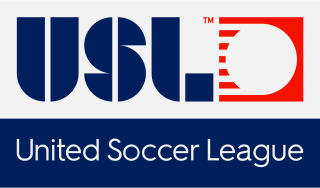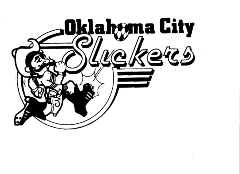
The USL Second Division was a professional men's soccer league in the United States, operated by United Soccer Leagues (USL). It was at the third tier of soccer in the United States, behind Major League Soccer and the USL First Division, and one step up from the USL Premier Development League and other leagues in the fourth tier.

United Soccer League (USL) is an organizer of soccer leagues in the United States. It operates several men's and women's leagues, both professional and amateur. Men's leagues currently organized are the USL Championship, USL League One, USL League Two, and the youth Super Y League. A women's league, the USL W League, began play in 2022. It is directly affiliated with the United States Soccer Federation and the United States Adult Soccer Association. The USL is headquartered in Tampa, Florida.

The Vancouver Whitecaps were a Canadian professional soccer club based in Vancouver, British Columbia. Founded in 1986, the team played its final year in the second tier of the United States soccer pyramid in the NASL Conference of the USSF Division 2 Professional League coached by Teitur Thordarson. The team played its home games at Swangard Stadium in nearby Burnaby, British Columbia. The team's colours were blue and white.

The United States soccer league system is a series of professional and amateur soccer leagues based, in whole or in part, in the United States. Sometimes called the American soccer pyramid, teams and leagues are not linked by the system of promotion and relegation typical in soccer elsewhere. Instead, the United States Soccer Federation defines professional leagues in three levels, called divisions, with all other leagues sanctioned by the USSF not having an official designated level or division.
Western Soccer Alliance was a professional soccer league featuring teams from the West Coast of the United States and Western Canada. The league began in 1985 as the Western Alliance Challenge Series. In 1986, it became the Western Soccer Alliance. In 1989, it existed for a single year as the Western Soccer League before merging with the American Soccer League to form the American Professional Soccer League in 1990.
San Francisco Bay Blackhawks were a professional soccer team which came into existence in 1989 as a team in the Western Soccer League (WSL). The Blackhawks spent time in the American Professional Soccer League (APSL) and the United States Interregional Soccer League (USISL). In 1993, the team competed in USISL as the San Jose Hawks, but left organized competition at the end of the season.
The Memphis Storm was an American soccer team based in Memphis, Tennessee which existed from 1986 to 1994. They underwent several names changes including the Rogues, the Survivors, the United Express and finally the Jackals. They played in the American Indoor Soccer Association, and the Sunbelt Independent Soccer League, which later came to be known as the United States Interregional Soccer League.

Sporting Arizona FC is an American soccer team based in Arizona. Founded in 1989, Sporting Arizona FC is Arizona's professional development club.
The Austin Lone Stars were a soccer club that competed in the SISL, USISL and United Soccer Leagues from 1987 to 2000. The club originally started in 1987/88 as the Austin Sockadillos in the original indoor SISL league. They became the Austin Lone Stars in 1994.
The New Mexico Chiles were an American soccer club established in 1990 which competed in the American Professional Soccer League. In 1991, the team merged with the New Mexico Roadrunners and moved to the USISL until its disestablishment in 1996.

The Oklahoma City Slickers was the name given to two different American soccer clubs based in Oklahoma City. The first team competed in the second American Soccer League in 1982 and 1983. The second Oklahoma City Slickers competed in the USISL from 1993 to 1996. Home games were played at historical Taft Stadium in Oklahoma City
Tim Martin is a former American soccer defender. Over his twelve-year professional career, he played with numerous teams in six leagues, winning the 1994 U.S. Open Cup with the San Francisco Greek-Americans and the 1991 American Professional Soccer League title with the San Francisco Bay Blackhawks. He also earned two caps with the U.S. national team. Since retiring from playing in 2000, he has become a college and youth soccer coach.
The second Tulsa Roughnecks were an American soccer team that played in the United Soccer Leagues from 1993–99.
Troy Snyder is a former U.S. soccer player who is second on the high school career scoring list with 208 goals and 117 assists. He spent most of his career playing indoor soccer, but also won an outdoor title in 1987 with the San Diego Nomads. Snyder earned five caps with the U.S. national team between 1985 and 1991 as well as another nine with the U.S. National Futsal Team. In 1983, he was a member of the U.S. team at the U-20 World Championship.
Cuauhtemoc “Temoc” Suarez is a retired American soccer player who spent three seasons in Major League Soccer, two in the National Professional Soccer League and five in the USL First Division. Suarez played for the United States Under-17 national team and also for the national futsal squad.
Jason Smith is a retired American soccer player and coach.
The 1996 USISL Select League season was the first season of a professional men's soccer league which featured teams from the United States. The league shared Division II status in the American soccer pyramid with the A-League, before the two leagues merged in 1997 as the USISL A-League.
Caesar Cervin is a retired American soccer midfielder. He played professionally in the Major Indoor Soccer League, United Soccer League and Southwest Indoor Soccer League (SISL). He later coached teams in the SISL where he was the 1991 Coach of the Year, USISL, Lone Star Soccer Alliance and was a fourteen-year assistant coach with the Dallas Sidekicks.

The American Professional Soccer League (APSL) was a professional men's soccer league with teams from the United States and later Canada. It was formed in 1990 by the merger of the third American Soccer League with the Western Soccer League. It was the first outdoor soccer league to feature teams from throughout the United States since the demise of the North American Soccer League in 1984.
The history of Vancouver Whitecaps FC, a professional soccer team based in Vancouver, Canada, spans over four decades. The first team to use the "Whitecaps" name was the Vancouver Whitecaps of the now-defunct North American Soccer League, playing from 1974 to 1984. After two years while the core of the players were focused on preparations for the 1986 World Cup, a second version of the club was founded in 1986 as the Vancouver 86ers. This team bought back the Whitecaps name in 2000 and has operated continuously in various leagues since 1986. A Whitecaps FC team began play in Major League Soccer starting in 2011 making it the first time since 1984 that a "Whitecaps" team played in the top tier of soccer in the United States and Canada.







